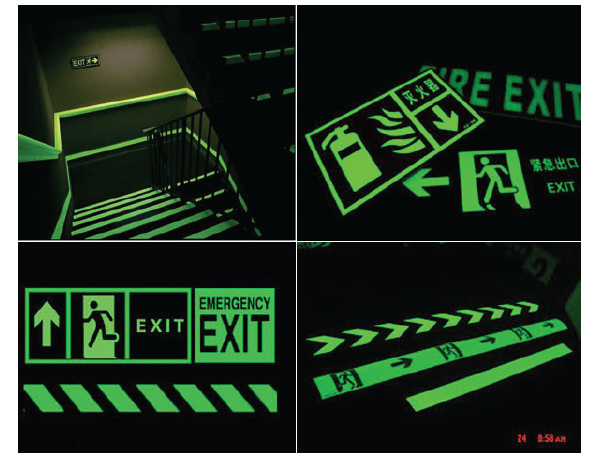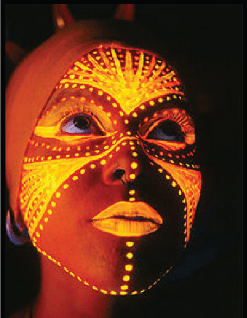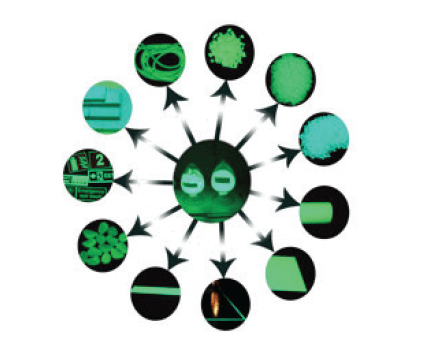What is the Luminous Paint?
Luminous paint is paint that exhibits luminescence. In other words, it gives off visible light through fluorescence, phosphorescence, or radioluminescence. There are three types of luminous paints.
1. Fluorescent Paint
Fluorescent paints offer a wide range of pigments and chroma which also ‘glow’ when exposed to the long wave “ultraviolet” frequencies. These UV frequencies are found in sunlight and some artificial lights.
In fluorescence the visible light component -sometimes known as “white light”- tends to be reflected and perceived normally, as colour; while the UV component of light is modified, ‘stepped down’ energetically into longer wavelengths, producing additional visible light frequencies, which are then emitted alongside the reflected white light.
Figure 1. Luminous paint will help you achieve fabulous glow effect of decoration or instruction
2. Phosphorescent Paint
Phosphorescent paint is commonly called “glow-inthe- dark” paint. It is made from phosphors such as silver-activated zinc sulfide or doped strontium aluminate, and typically glows a pale green to greenish-blue color.
The mechanism for producing light is similar to that of fluorescent paint, but the emission of visible light persists long after it has been exposed to light. Phosphorescent paints have a sustained glow which lasts for up to 12 hours after exposure to light, fading over time.
This type of paint has been used to mark escape paths in aircraft and for decorative use such as “stars” applied to walls and ceilings. It is an alternative to radioluminescent paint.
3. Radioluminescent Paint
Radioluminescent paint was invented in 1908 by Sabin Arnold von Sochocky and originally incorporated radium-226. Radium is a radiological hazard, emitting gamma rays that can penetrate a glass watch dial and into human tissue.
During the 1920s and 1930s, the harmful effects of this paint became increasingly clear. A notorious case involved the “Radium Girls”, a group of women who painted watch faces and later suffered adverse health effects from ingestion. In 1928, Dr von Sochocky himself died of aplastic anemia as a result of radiation exposure.
Radium was banned from this use decades ago by international law, but the thousands of legacy radium dials still owned by the public can be a dangerous source of radioactive contamination.
The phosphor degrades relatively fast and the dials lose luminosity in several years to a few decades; clocks and other devices available from antique shops and other sources therefore are not luminous anymore. However, due to the long 1600-year half-life of the Ra-226 isotope they are still radioactive and can be identified with a Geiger counter.
Figure 2. The women painted her face with the glong substance
Radioluminescent paint is a self-luminous paint that consists of a small amount of a radioactive isotope (radionuclide) mixed with a radioluminescent phosphor chemical. The radioisotope continually decays, emitting radiation particles which strike molecules of the phosphor, exciting them to emit visible light.
The isotopes selected are typically strong emitters of beta radiation, preferred since this radiation will not penetrate an enclosure. Radioluminescent paints will glow without exposure to light until the radioactive isotope has decayed (or the phosphor degrades), which may be many years.
What is the Difference Between Fluorescent and Phosphorescent Paints?
Fluorescent materials tend to emit absorbed energy very rapidly – they’ll glow as long as there’s a source of light to excite the material (typically with what’s described as “neon” coloration) but emission takes place over a time scale of mere nanoseconds, so they will go dark the instant a light source is removed.
Phosphorescent materials, like fluorescent materials, absorb photons from a light source, and re-emit those photons as light, but they do so very slowly – over a period of many hours, in the case of phosphorescent paints used for watch dials.
The main uses are as below:
• Photoluminescent sheet,
• Photoluminescent tape,
• Military instrument,
• Emergency signs,
• Plastic molding,
• Ceramic tiles,
• Road signs,
• Watches.
In brief; they can be used to produce luminous products with good indicating and beautifying effects in darkness.

Figure 3. Applications areas
What is The Importance of Luminous Paint?
Luminous simply means giving off light. According to the structure which has been applied, luminous paints can give back the light during 1-24 hours when the electricity cut or in dark.
For countries that currently have limited access to electricity, luminous paints can be offered as an alternative solution in daily life.
“Reference to IEA World Energy Outlook 2017; an estimated 675 million people cannot reach electricity in 2030. 600 million whereof this number is estimated to be in the Sub-Saharan Africa region.”
Öznur Kurt – Product and Service Development Jr. Specialist – Aleph Petrol ve Kimya Ürünleri San. Tic. A.Ş.




